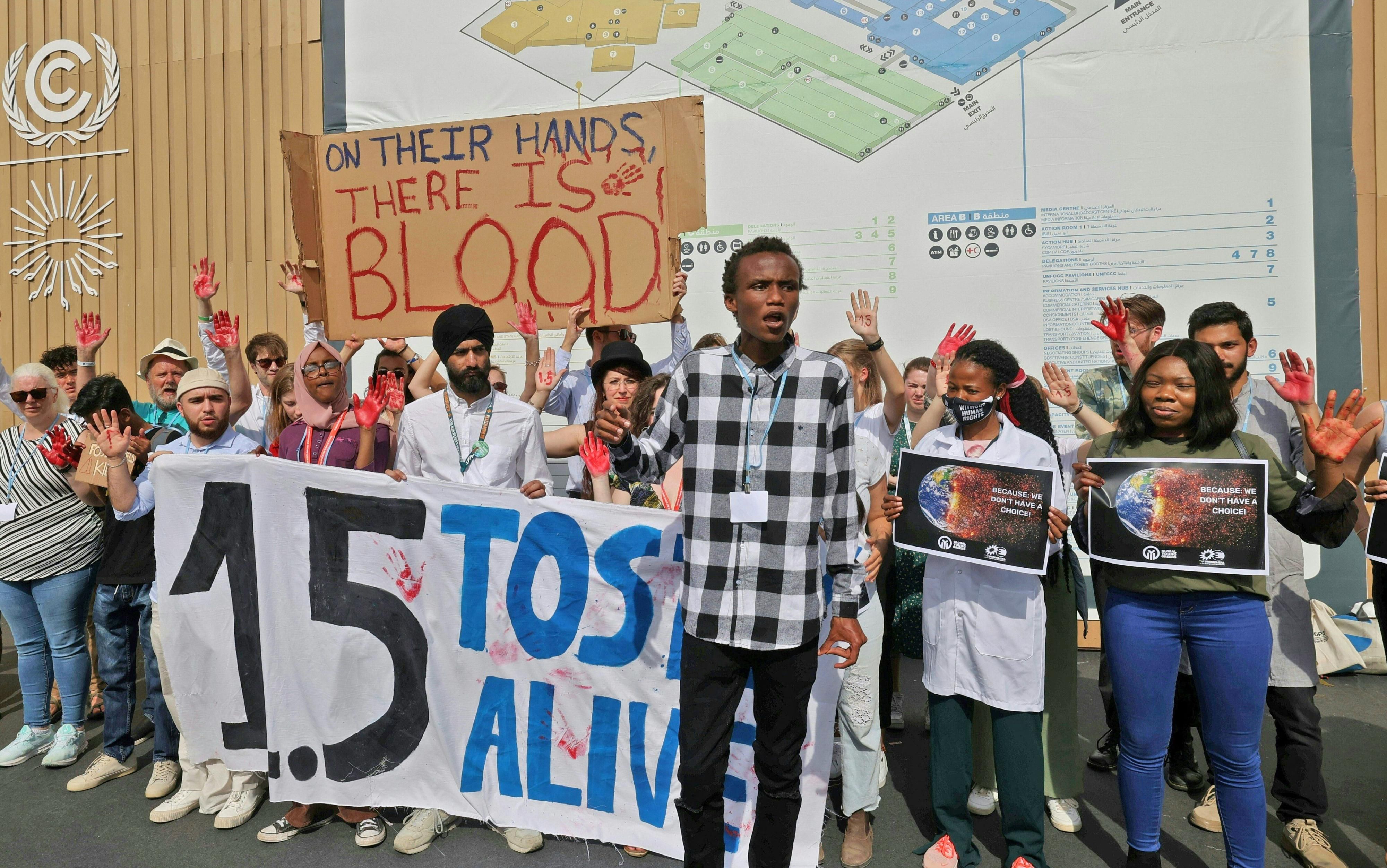‘Deeply Depressing’ Study Shows Planet-Warming Emissions Continue to Rise
“If current emissions levels persist, there is now a 50% chance that global warming of 1.5°C will be exceeded in nine years.”
Republished from Common Dreams under Creative Commons (CC BY-NC-ND 3.0). Feel free to republish and share widely.

JAKE JOHNSONNovember 11, 2022
Rapid and drastic cuts to global greenhouse gas emissions are necessary to curb warming and prevent the most dire climate scenarios from becoming reality.
But a new study released Friday by the Global Carbon Project finds “no sign of the decrease that is urgently needed” as emissions remain at record levels this year, with fossil fuel giants and governments plowing ahead with new extraction efforts that could push critical climate targets out of reach.
Scientists with the Global Carbon Project estimate that total CO2 emissions will reach 40.6 billion tonnes this year—driven by rising pollution from fossil fuels—and will likely continue to rise in 2023 without bold action from policymakers worldwide.
“If current emissions levels persist, there is now a 50% chance that global warming of 1.5°C will be exceeded in nine years,” the researchers note. “Projected emissions from coal and oil are above their 2021 levels, with oil being the largest contributor to total emissions growth.”
“The 2022 picture among major emitters is mixed: emissions are projected to fall in China (0.9%) and the E.U. (0.8%), and increase in the USA (1.5%) and India (6%), with a 1.7% rise in the rest of the world combined,” the report finds.
Professor Pierre Friedlingstein of Exeter’s Global Systems Institute, the lead author of the new study, lamented in a statement that “we see yet another rise in global fossil CO2 emissions” in 2022 “when we need a rapid decline.”
“There are some positive signs,” Friedlingstein added, pointing to the slowing growth of fossil fuel emissions over the long term, “but leaders meeting at COP27 will have to take meaningful action if we are to have any chance of limiting global warming close to 1.5°C.”
That increasingly imperiled warming target remains a focus as world leaders gather in Sharm El-Sheikh, Egypt for the annual United Nations climate conference, a key opportunity for nations to commit to collective action against a climate emergency that is wreaking havoc worldwide.
Climate campaigners warn the opportunity is at risk of being squandered as Big Oil lobbyists swarm the conference and gas producers use the event to push their dirty energy source as a “transition fuel.”
Professor Corinne Le Quéré of the University of East Anglia, a co-author of the Global Carbon Project study, said that if governments respond to worsening climate chaos “by turbocharging clean energy investments and planting, not cutting, trees, global emissions could rapidly start to fall.”
“We are at a turning point and must not allow world events to distract us from the urgent and sustained need to cut our emissions to stabilize the global climate and reduce cascading risks,” Le Quéré warned.
Allowing planetary heating to exceed 1.5°C above preindustrial levels by the end of the century would spell disaster for large swaths of the planet as trends already seen around the world—from increasingly extreme weather events to species extinctions to rapidly melting sea ice—would accelerate, potentially locking in irreversible climate damage.
Professor Mark Maslin of University College London told The Guardian that the Global Carbon Project study is “deeply depressing.”
“It sends a clear message to the leaders at COP27—the world needs to have significant cuts in global emissions in 2023 if we are to have any chance to keep climate change to 1.5°C,” said Maslin.
Republished from Common Dreams under Creative Commons (CC BY-NC-ND 3.0). Feel free to republish and share widely.
Related

Analysis Exposes Big Oil’s Plot to Unleash Climate-Killing ‘Carbon Bombs’ Worldwide
Jake Johnson · May 11, 2022

Climate Crisis Pushing Up to 1 in 6 US Tree Species Toward Extinction: Study
Julia Conley · Aug 23, 2022

‘Abdication of Responsibility’: Fury as COP27 Draft Omits Oil and Gas Phase-Out
Julia Conley · Nov 17, 2022

‘We Must Wake Up!’ Study Says Climate Tipping Points Loom—But Some Are Avoidable
Brett Wilkins · Sep 8, 2022
After COP27, all signs point to world blowing past the 1.5 degrees global warming limit – here’s what we can still do about it

Peter Schlosser, Arizona State University
The world could still, theoretically, meet its goal of keeping global warming under 1.5 degrees Celsius, a level many scientists consider a dangerous threshold. Realistically, that’s unlikely to happen.
Part of the problem was evident at COP27, the United Nations climate conference in Egypt.
While nations’ climate negotiators were successfully fighting to “keep 1.5 alive” as the global goal in the official agreement, reached Nov. 20, 2022, some of their countries were negotiating new fossil fuel deals, driven in part by the global energy crisis. Any expansion of fossil fuels – the primary driver of climate change – makes keeping warming under 1.5 C (2.7 Fahrenheit) compared to pre-industrial times much harder.
Attempts at the climate talks to get all countries to agree to phase out coal, oil, natural gas and all fossil fuel subsidies failed. And countries have done little to strengthen their commitments to cut greenhouse gas emissions in the past year.
There have been positive moves, including advances in technology, falling prices for renewable energy and countries committing to cut their methane emissions.
But all signs now point toward a scenario in which the world will overshoot the 1.5 C limit, likely by a large amount. The World Meteorological Organization estimates global temperatures have a 50-50 chance of reaching 1.5C of warming, at least temporarily, in the next five years.
That doesn’t mean humanity can just give up.
Why 1.5 degrees?
During the last quarter of the 20th century, climate change due to human activities became an issue of survival for the future of life on the planet. Since at least the 1980s, scientific evidence for global warming has been increasingly firm , and scientists have established limits of global warming that cannot be exceeded to avoid moving from a global climate crisis to a planetary-scale climate catastrophe.
There is consensus among climate scientists, myself included, that 1.5 C of global warming is a threshold beyond which humankind would dangerously interfere with the climate system. https://ourworldindata.org/grapher/temperature-anomaly?time=earliest..latest
We know from the reconstruction of historical climate records that, over the past 12,000 years, life was able to thrive on Earth at a global annual average temperature of around 14 C (57 F). As one would expect from the behavior of a complex system, the temperatures varied, but they never warmed by more than about 1.5 C during this relatively stable climate regime.
Today, with the world 1.2 C warmer than pre-industrial times, people are already experiencing the effects of climate change in more locations, more forms and at higher frequencies and amplitudes.
Climate model projections clearly show that warming beyond 1.5 C will dramatically increase the risk of extreme weather events, more frequent wildfires with higher intensity, sea level rise, and changes in flood and drought patterns with implications for food systems collapse, among other adverse impacts. And there can be abrupt transitions, the impacts of which will result in major challenges on local to global scales. https://www.youtube.com/embed/MR6-sgRqW0k?wmode=transparent&start=0 Tipping points: Warmer ocean water is contributing to the collapse of the Thwaites Glacier, a major contributor to sea level rise with global consequences.
Steep reductions and negative emissions
Meeting the 1.5 goal at this point will require steep reductions in carbon dioxide emissions, but that alone isn’t enough. It will also require “negative emissions” to reduce the concentration of carbon dioxide that human activities have already put into the atmosphere.
Carbon dioxide lingers in the atmosphere for decades to centuries, so just stopping emissions doesn’t stop its warming effect. Technology exists that can pull carbon dioxide out of the air and lock it away. It’s still only operating at a very small scale, but corporate agreements like Microsoft’s 10-year commitment to pay for carbon removed could help scale it up.
A report in 2018 by the Intergovernmental Panel on Climate Change determined that meeting the 1.5 C goal would require cutting carbon dioxide emissions by 50% globally by 2030 – plus significant negative emissions from both technology and natural sources by 2050 up to about half of present-day emissions.

Can we still hold warming to 1.5 C?
Since the Paris climate agreement was signed in 2015, countries have made some progress in their pledges to reduce emissions, but at a pace that is way too slow to keep warming below 1.5 C. Carbon dioxide emissions are still rising, as are carbon dioxide concentrations in the atmosphere.
A recent report by the United Nations Environment Program highlights the shortfalls. The world is on track to produce 58 gigatons of carbon dioxide-equivalent greenhouse gas emissions in 2030 – more than twice where it should be for the path to 1.5 C. The result would be an average global temperature increase of 2.7 C (4.9 F) in this century, nearly double the 1.5 C target.
Given the gap between countries’ actual commitments and the emissions cuts required to keep temperatures to 1.5 C, it appears practically impossible to stay within the 1.5 C goal.
Global emissions aren’t close to plateauing, and with the amount of carbon dioxide already in the atmosphere, it is very likely that the world will reach the 1.5 C warming level within the next five to 10 years.

How large the overshoot will be and for how long it will exist critically hinges on accelerating emissions cuts and scaling up negative emissions solutions, including carbon capture technology.
At this point, nothing short of an extraordinary and unprecedented effort to cut emissions will save the 1.5 C goal. We know what can be done – the question is whether people are ready for a radical and immediate change of the actions that lead to climate change, primarily a transformation away from a fossil fuel-based energy system.
Peter Schlosser, Vice President and Vice Provost of the Julie Ann Wrigley Global Futures Laboratory, Arizona State University
This article is republished from The Conversation under a Creative Commons license. Read the original article.
‘Abdication of Responsibility’: Fury as COP27 Draft Omits Oil and Gas Phase-Out
Republished from Common Dreams under Creative Commons (CC BY-NC-ND 3.0). Feel free to republish and share widely.
“At a COP shaped by more than 600 fossil-fuel lobbyists roaming the halls, parties fighting for progress must push back against weak language that allows the fossil fuel industry to continue its deadly expansion,” said one campaigner.

Julia Conley November 17, 2022
Climate action groups were outraged Thursday as global policymakers released a draft agreement making clear that dire warnings from energy experts and scientists regarding fossil fuel extraction have not gotten through to them, with the document failing to endorse a phase-out of oil and gas use.
The draft agreement was published as the 2022 United Nations Climate Change Conference (COP27) comes to a close in Sharm el-Sheikh, Egypt, and is expected to be heavily revised in the coming days.
“As climate impacts and injustice accelerate, lives, livelihoods, cultures, and even whole countries are lost, the latest draft cover note from the COP27 presidency pushes the pedal to the metal on the highway to climate hell.”
The absence of crucial language regarding oil and gas left campaigners concerned that the conference, where hundreds of fossil fuel lobbyists were present, will ultimately fail to produce an agreement that treats the climate crisis with the urgency needed.
“We came to Sharm el-Sheikh to demand real action on meeting and exceeding climate finance and adaptation commitments, a phase-out of all fossil fuels and for rich countries to pay for the loss and damage done to the most vulnerable communities within developing countries by agreeing a Loss and Damage Finance Fund,” said Yeb Saño, Greenpeace International’s head of delegation at the summit. “None of that is on offer in this draft. Climate justice will not be served if this sets the bar for a COP27 outcome.”
The draft agreement “encourages the continued efforts to accelerate measures towards the phase-down of unabated coal power and phase out and rationalize inefficient fossil fuel subsidies.”
It also echoes the call in last year’s document out of COP26 to emphasize “the importance of exerting all efforts at all levels to achieve the Paris agreement temperature goal of holding the increase in the global average temperature to well below 2°C above pre-industrial levels and pursuing efforts to limit the temperature increase to 1.5°C above pre-industrial levels.”
But the omission of a phase-out of all fossil fuel extraction, which delegates from India have lobbied for at COP27 and which the U.S., U.K., and European Union expressed conditional support for in recent days, denotes a draft document that “ignores the science of 1.5°C” even as it pledges to limit the temperature increase, said Tzeporah Berman, chair of the Fossil Fuel Non-Proliferation Treaty Initiative.
“Acknowledging only the need to phase down coal while ignoring oil and gas is hugely problematic. This predatory delay is out of line with the science and with 1.5 degrees,” Collin Rees, campaign manager at Oil Change International, told Bloomberg. “At a COP shaped by more than 600 fossil-fuel lobbyists roaming the halls, parties fighting for progress must push back against weak language that allows the fossil fuel industry to continue its deadly expansion.”
The draft is the first agreement out of an annual U.N. climate conference to address “loss and damage”—the harms already suffered by countries in the Global South due to the climate crisis and the need for wealthy governments to help finance their recovery.
The document does not provide details about how a loss and damage fund would operate, saying only that it “welcomes” the inclusion of the issue in the final agreement.
“More than 40 million people in the Horn of Africa are currently experiencing climate-induced hunger crisis,” said Nafkote Dabi, climate change policy lead for Oxfam, on Wednesday. “Pakistan is faced with $30 billion worth of loss and damage from the recent mass floods that left a third of the country under water. It is crucial that developing countries can access a formal fund to pay for the damages and losses they are already suffering today.”
Rich countries must meet their $100 billion annual goal for climate finance in addition to establishing a new Loss and Damage fund that is fit for purpose, accessible and gender responsive,” Dabi added. “Rich countries must heed the urgent call and deliver a loss and damage fund at COP27.”
Related Content

As COP27 Failure Looms, Climate Movement Demands: ‘Phase Out All Fossil Fuels’
The document includes some areas of improvement over the agreement written at COP26 last year, such as a call for multilateral development banks to scale up climate finance “without exacerbating debt burdens” for countries in the Global South, but leaves out details on how wealthy countries must strengthen their emissions-slashing targets.
“There should be a clear road map by those who are emitting a lot to start reducing their emissions,” Collins Nzovu, Zambia’s environment minister, told Bloomberg. “We are headed completely in the wrong direction—driving very, very fast into a ditch.”
Saño condemned the draft as “an abdication of responsibility to capture the urgency expressed by many countries to see all oil and gas added to coal for at least a phase-down.”
“As climate impacts and injustice accelerate, lives, livelihoods, cultures, and even whole countries are lost,” he added, “the latest draft cover note from the COP27 presidency pushes the pedal to the metal on the highway to climate hell.”
Republished from Common Dreams under Creative Commons (CC BY-NC-ND 3.0). Feel free to republish and share widely.
